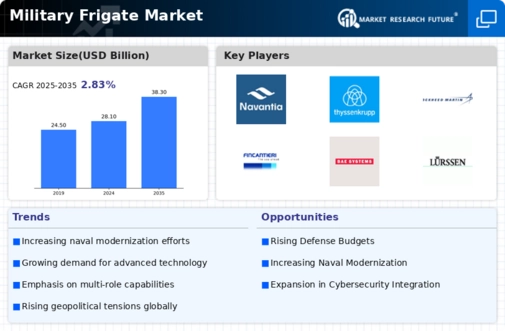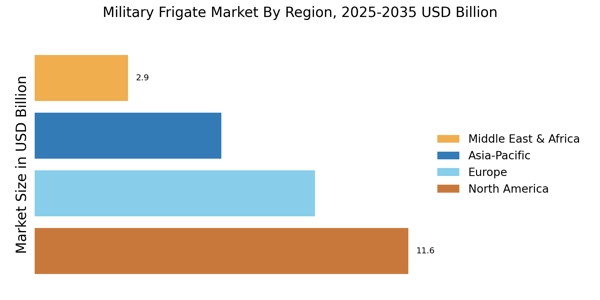Increasing Defense Budgets
The Military Frigate Market is experiencing a notable surge in defense budgets across various nations. Governments are prioritizing naval capabilities to enhance maritime security and protect national interests. For instance, recent reports indicate that several countries have allocated substantial funds for the procurement of advanced frigates, which are essential for modern naval warfare. This trend is likely to continue, as nations recognize the importance of maintaining a robust naval presence. The increase in defense spending is projected to drive the Military Frigate Market, with estimates suggesting a compound annual growth rate of around 4.5% over the next decade. As nations invest in their naval fleets, the demand for technologically advanced frigates is expected to rise, further propelling market growth.
Rising Maritime Security Concerns
The Military Frigate Market is significantly influenced by escalating maritime security concerns. With the rise of piracy, territorial disputes, and illegal fishing, nations are compelled to enhance their naval capabilities. Frigates, known for their versatility and advanced surveillance systems, play a crucial role in addressing these challenges. Recent data indicates that the demand for frigates has increased as countries seek to bolster their maritime security frameworks. The need for effective patrolling and rapid response capabilities is driving investments in frigate procurement. As geopolitical tensions persist, the Military Frigate Market is likely to witness sustained growth, with an emphasis on acquiring vessels equipped with state-of-the-art technology to ensure maritime safety.
Strategic Alliances and Partnerships
The Military Frigate Market is witnessing a rise in strategic alliances and partnerships among nations and defense contractors. Collaborative efforts are being made to develop and produce advanced frigates that meet the evolving demands of modern naval warfare. These partnerships often lead to shared resources, technology transfer, and cost-effective solutions. Recent collaborations between countries have resulted in the co-development of frigates that incorporate the latest technological advancements. This trend is likely to enhance the competitiveness of the Military Frigate Market, as nations leverage collective expertise to produce superior vessels. The formation of such alliances is expected to contribute to a more dynamic market landscape, fostering innovation and efficiency in frigate production.
Focus on Environmental Sustainability
The Military Frigate Market is increasingly aligning with environmental sustainability initiatives. As concerns about climate change and environmental impact grow, navies are exploring eco-friendly technologies for their fleets. The development of frigates that utilize alternative fuels and energy-efficient systems is becoming a priority. Recent initiatives have shown that integrating sustainable practices into naval operations can enhance operational efficiency while reducing the carbon footprint. This shift towards sustainability is likely to influence procurement decisions, as nations seek to modernize their fleets in an environmentally responsible manner. The Military Frigate Market may see a rise in demand for vessels that not only meet operational requirements but also adhere to sustainability standards, potentially reshaping the future of naval warfare.
Technological Innovations in Naval Warfare
The Military Frigate Market is undergoing a transformation due to rapid technological innovations in naval warfare. Advancements in automation, artificial intelligence, and weaponry are reshaping the capabilities of modern frigates. These vessels are now equipped with sophisticated systems that enhance their operational efficiency and combat readiness. For example, the integration of unmanned systems and advanced radar technologies is becoming increasingly common. This trend is expected to drive the Military Frigate Market, as navies seek to modernize their fleets to maintain a competitive edge. The adoption of cutting-edge technologies is projected to result in a market growth rate of approximately 5% annually, as nations invest in next-generation frigates that can operate effectively in complex maritime environments.


















Leave a Comment